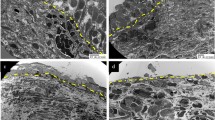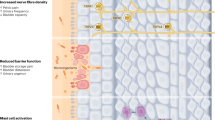Abstract
Treating interstitial cystitis (IC) is one of the greatest challenges facing physicians and other health care providers who manage patients with this condition. The symptoms of urinary frequency and urgency, dysuria, and chronic pelvic pain characterize IC, but it is the debilitating pelvic pain associated with IC that is most difficult to control. The pathophysiology of IC pain is poorly understood, but is thought to be a complex entity including nociceptive, visceral, and neuropathic components. There are currently no universally effective therapies available. Oral treatments, however, are frequently used, including nonsteroidal anti-inflammatory drugs, tricyclic antidepressants, gabapentin, and pentosan polysulfate, all of which have shown varying degrees of efficacy. Recognition that IC pain is multifactorial, and probably has a neuropathic component, has led to the use of some of these agents, previously prescribed for other neurologic conditions associated with chronic pain. Intravesical and surgical options are also available, which expands the armamentarium for those who treat pain secondary to IC. Treating IC requires managing all of the symptoms of this disease. This review aims to cover standard and novel treatment options, while concentrating on the management of pain.
Key Points
-
Interstitial cystitis (IC) is characterized by lower urinary tract symptoms of frequency, dysuria, urgency and chronic pelvic pain
-
The pathophysiology of IC is poorly understood, and several mechanisms have been implicated in this chronic condition
-
The majority of treatments for IC are aimed at treating the pain associated with the disorder, which is the most debilitating symptom
-
Several oral agents have been shown to be effective in controlling the pain associated with IC in some patients, including narcotics, antidepressants, gabapentin and pentosan polysulfate
-
Some invasive therapies such as hydrodistension, intravesIcal treatments and sacral neuromodulation are also being investigated for the treatment of IC
This is a preview of subscription content, access via your institution
Access options
Subscribe to this journal
Receive 12 print issues and online access
$209.00 per year
only $17.42 per issue
Buy this article
- Purchase on Springer Link
- Instant access to full article PDF
Prices may be subject to local taxes which are calculated during checkout
Similar content being viewed by others
References
Nordling J (2004) Interstitial cystitis: how should we diagnose it and treat it in 2004? Curr Opin Urol 14: 323–327
Hanno P et al. (2005) International consultation on IC—Rome, September 2004/Forging an international consensus: progress in painful bladder syndrome/interstitial cystitis. Int Urogynecol J Pelvic Floor dysfunct 16 (Suppl 1): S2–S34
Jones CA and Nyberg L (1997) Epidemiology of interstitial cystitis. Urology 49: 2–9
Parsons CL (2003) Prostatitis, interstitial cystitis, chronic pelvic pain, and urethral syndrome share a common pathophysiology: lower urinary dysfunctional epithelium and potassium recycling. Urology 62: 976–982
Foster HE (1999) Urologic causes of pelvic pain. Infertility Reprod Med Clin North Am 10: 701–715
Oleary MP et al. (1997) The interstitial cystitis symptom index and problem index. Urology 49 (Suppl 5A): S58–S63
Parsons CL et al. (2002) Increased prevalence of interstitial cystitis: previously unrecognized urologic and gynecologic cases identified using a new symptom questionnaire and intravesical potassium sensitivity. Urology 60: 573–578
Propert KJ et al. (2002) Pitfalls in the design of clinical trials for interstitial cystitis. Urology 60: 742–748
Rovner E et al. (2000) Treatments used in women with interstitial cystitis: the interstitial cystitis data base (ICDB) study experience. The Interstitial Cystitis Data Base Study Group. Urology 56: 940–945
Brookoff D (1997) The causes and treatment of pain in interstitial cystitis. In Interstitial Cystitis, 247–255 (Ed Sant GR) Philadelphia: Lippincott–Raven
Ratliff TL et al. (1994) The etiology of interstitial cystitis. Urol Clin N Amer 21: 21–30
Henry RA et al. (2001) Alkalinized intravesical lidocaine to treat interstitial cystitis: absorption kinetics in normal and interstitial cystitis bladders. Urology 57 (Suppl 1): S119
Parsons CL (2005) Successful downregulation of bladder sensory nerves with combination of heparin and alkalinized lidocaine in patients with interstitial cystitis. Urology 65: 45–48
Wong D et al. (1998) Nalmefene: a long acting opioid. J Emerg Med 16: 471–475
Stone N (1994) Nalmefene in the treatment of interstitial cystitis. Urol Clin North Am 21: 101–106
Lynes WL et al. (1987) Mast cell involvement in interstitial cystitis J Urol 138: 746–752
Theoharides TC et al. (1997) Hydroxyzine therapy for interstitial cystitis. Urology 49 (Suppl 5A): S108–S110
Sant GR et al. (2003) A pilot clinical trial of oral pentosan polysulfate and oral hydroxyzine in patients with interstitial cystitis. J Urol 170: 810–815
Casale TB et al. (1984) Induction of human cutaneous mast cell degranulation by opiates and endogenous opioid peptides: evidence for opiate and nonopiate receptor participation. J Allergy Clin Immunol 73: 775–781
Sant GR and Theoharides TC (1994) The role of the mast cell in interstitial cystitis. Urol Clin North Am 21: 41–53
Minogiannis P et al. (1998) Hydroxyzine inhibits neurogenic bladder mast cell activation. Int J Immunopharmacol 20: 553–563
Kahn B et al. (2005) Management of patients with interstitial cystitis or chronic pelvic pain of bladder origin: a consensus report. Curr Med Res Opin 21: 509–516
Mulholland SG et al. (1990) Pentosan polysulfate sodium for the therapy of interstitial cystitis—a double blind placebo controlled clinical study. Urology 35: 552–558
Nickel JC et al. (2005) Randomized, double-blind, dose-ranging study of pentosan polysulfate sodium for interstitial cystitis. Urology 65: 654–658
Hanno PM and Wein AJ (1987) Medical treatment of interstitial cystitis (other than Rimso-50/Elmiron). Urology 29 (Suppl): S22–S26
van Ophoven A et al. (2004) A prospective, randomized, placebo controlled, double-blind study of amitriptyline for the treatment of interstitial cystitis. J Urol 172: 533–536
Pilowsky I et al. (1982) A controlled study of amitriptyline in the treatment of chronic pain. Pain 14: 169–179
Backonga M and Glanzman RL (2003) Gabapentin dosing for neuropathic pain: evidence from randomized, placebo-controlled clinical trials. Clin Ther 25: 81–104
Gee NS et al. (1996) The novel anticonvulsant drug, gabapentin (Neurontin), binds to the alpha2delta subunit of a calcium channel. J Biol Chem 271: 5768–5776
Nicholson B (2000) Gabapentin use in neuropathic pain syndromes. Acta Neurol Scand 101: 359–371
Sasaki K et al. (2001) Oral gabapentin treatment for refractory genitourinary tract pain. Tech Urol 7: 47–49
Hansen H (2000) Interstitial cystitis and the potential role of gabapentin. South Med J 93: 238–242
Hindmarch I et al. (2005) A double-blind, placebo- and positive-internal-controlled (alprazolam) investigation of the cognitive and psychomotor profile of pregabalin in healthy volunteers. Psychopharmacology 183: 133–143
Freyhagen R et al. (2005) Efficacy of pregabalin in neuropathic pain evaluated in a 12-week, randomised, double-blind, multicentre, placebo-controlled trial of flexible- and fixed-dose regimens. Pain 115: 254–263
Soucy F and Gregoire M (2005) Efficacy of prednisone for severe refractory ulcerative interstitial cystitis. J Urol 173: 841–843
Forsell T et al. (1996) Cyclosporine in severe interstitial cystitis. J Urol 155: 1591–1593
Sairanen J et al. (2004) Long-term outcome of patients with interstitial cystitis treated with low dose cyclosporine A. J Urol 171: 2138–2141
Turner K and Stewart H (2005) How do you stretch a bladder? A survey of UK practice, literature review, and a recommendation of a standard approach. Neurourol Urodyn 24: 74–76
Hanno P and Wein A (1991) Conservative therapy for interstitial cystitis. Semin Urol 9: 143–147
Yamada T et al. (2003) Adjuvant hydrodistension under epidural anesthesia for interstitial cystitis. Int J Urol 10: 463–468
Moldwin R and Sant GR (2002) Interstitial cystitis: a pathophysiology and treatment update. Clin Obstet Gynecol 45: 259–272
Stewart BH et al. (1967) The use of dimethyl sulfoxide (DMSO) in the treatment of interstitial cystitis. J Urol 98: 671–672
Perez-Marrero R et al. (1988) A controlled study of dimethyl sulfoxide in interstitial cystitis. J Urol 140: 36–39
Perez-Marrero R et al. (2003) Prolongation of response to DMSO by heparin maintenance. Urology 41: 64–66
Rossberger J et al. (2005) Critical appraisal of dimethyl sulfoxide treatment for interstitial cystitis: discomfort, side effects and treatment outcome. Scand J Urol Nephrol 39: 73–77
Zeidman EJ et al. (1994) Bacillus Calmette–Guerin immunotherapy for refractory interstitial cystitis. Urology 43: 121–124
Peters D et al. (1997) The efficacy of intravesical Tice strain bacillus Calmette–Guèrin in the treatment of interstitial cystitis: a double-blind, prospective, placebo controlled trial. J Urol 157: 2090–2094
Peters KM et al. (1998) The efficacy of intravesical bacillus Calmette–Guerin in the treatment of interstitial cystitis: long term followup. J Urol 159: 1483–1486
Mayer R et al. (2005) A randomized controlled trial of intravesical bacillus Calmette–Guèrin for treatment refractory interstitial cystitis. J Urol 173: 1186–1191
Payne CK et al. (2005) Intravesical resiniferatoxin for the treatment of interstitial cystitis: a randomized, double blind, placebo controlled trial. J Urol 173: 1590–1594
Schmidt RA et al. (1979) Urinary bladder and sphincter responses to stimulation of dorsal and ventral sacral roots. Invest Urol 16: 300–304
Hassouna MM et al. (2000) Sacral neuromodulation in the treatment of urgency–frequency symptoms: a multicenter study of efficacy and safety. J Urol 163: 1849–1854
Abrams P et al. (2003) The role of neuromodulation in the management of urinary urge incontinence. BJU Int 91: 355–359
Siegel S et al. (2001) Sacral nerve stimulation in patients with intractable pelvic pain. J Urol 166: 1742–1745
Peters KM and Carey JM (2003) Sacral neuromodulation for the treatment of refractory interstitial cystitis: outcomes based on technique. Int Urogynecol J Pelvic Floor Dysfunct 14: 223–228
Peters KM and Konstandt D (2004) Sacral neuromodulation decreases narcotic requirements in refractory interstitial cystitis. BJU Int 93: 777–779
Sairanen J et al. (2005) Cyclosporin A and pentosan polysulfate sodium for the treatment of interstitial cystitis. J Urol 174: 2235–2238
Author information
Authors and Affiliations
Corresponding author
Ethics declarations
Competing interests
Harris E Foster, Jr is a consultant for Ortho Urology.
Rights and permissions
About this article
Cite this article
Phatak, S., Foster Jr, H. The management of interstitial cystitis: an update. Nat Rev Urol 3, 45–53 (2006). https://doi.org/10.1038/ncpuro0385
Received:
Accepted:
Issue Date:
DOI: https://doi.org/10.1038/ncpuro0385
This article is cited by
-
Therapeutic effect of urine-derived stem cells for protamine/lipopolysaccharide-induced interstitial cystitis in a rat model
Stem Cell Research & Therapy (2017)
-
Mesenchymal stem cells protect against the tissue fibrosis of ketamine-induced cystitis in rat bladder
Scientific Reports (2016)
-
Intravesical hyaluronic acid and chondroitin sulphate for bladder pain syndrome/interstitial cystitis: long-term treatment results
International Urogynecology Journal (2012)
-
A case of perineal pain related to interstitial cystitis which was supposed to be relieved with gabapentin
Journal of Anesthesia (2009)



